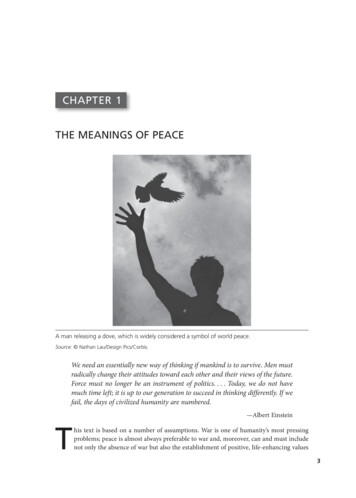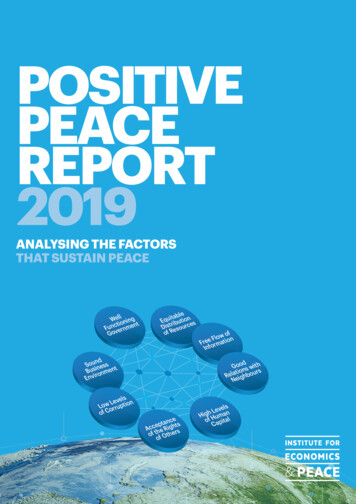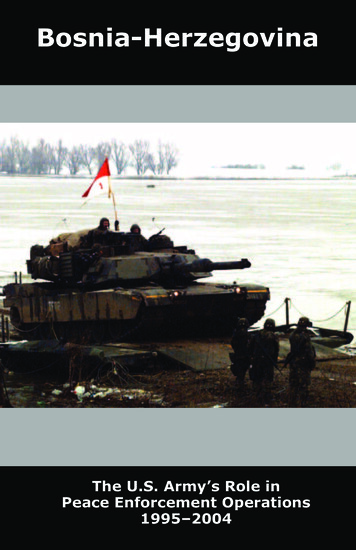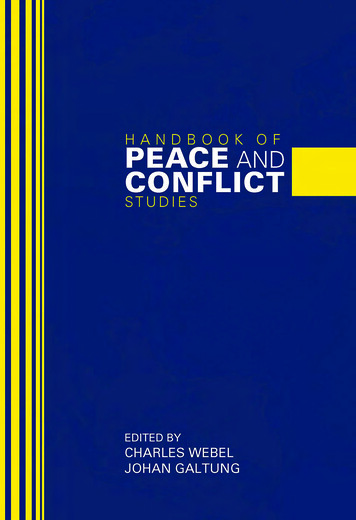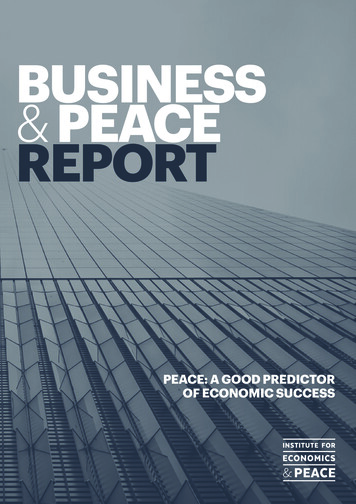
Transcription
BUSINESS& PEACEREPORTPEACE: A GOOD P REDICTOROF ECONOMIC SUCCESS
Quantifying Peace and its Benefits
ContentsExecutive summary2Introduction4Global Peace Index and BusinessEconomic prosperity, peace and businessMacroeconomic stability and investmentForeign direct investment and peacePeace and the Nature of Constraints to Investors88111213Positive Peace and BusinessPillars of Positive Peace and Business performanceEconomic-wide effects of Positive Peace141417Endnotes20BUSINESS & PEACE REPORT 1
ExecutivesummaryThis report analyses the relationship between theeconomic performance of a country and its levels ofpeace. The major finding of this report is that peace actsas a good predictor of a country’s future performance ina number of macroeconomic indicators. These insightscan be used to better assess the expected investmentpotential of countries.Rather than asking what businesses can do for peace, thestudy differentiates itself from other work by focusing onwhat peace can offer businesses. Institute for Economics& Peace (IEP) sees this as an important but missing step inbusiness analysis. In order for businesses to be an actor inbuilding peace, investors first need to see the benefits ofpeace to their investment decisions.The results of this work show that economic performancecan be predicted by understanding the movement in thesame socio-economic factors that affect peacefulness.These conditions are known as Positive Peace. The countriesthat improved the most in Positive Peace between 2010and 2016 also had substantially above average economicperformance.Five macroeconomic indicators were analysed through twodifferent measures of peace: the Global Peace Index (GPI),which measures the absence of violence or fear of violence,and the Positive Peace Index (PPI), which measures theattitudes, institutions and structures that create and sustainpeaceful societies. IEP’s research has found that measures ofPositive Peace are a good indicator of future levels of peaceand of macroeconomic performance.Countries who currently have low levels of violence or fear ofviolence, as measured by the GPI, over the last six decadeshave averaged 3 times the gross domestic product (GDP)growth rates of countries ranked at the bottom of the GPIover the same period. Similarly, countries that performwell on the GPI have lower inflation rates, easier access tofinancing, and higher rates of foreign direct investment (FDI).However, defining peace solely by levels of violence doesnot provide a complete picture of the future prospects forpeace and business. Changes in Positive Peace are a moreaccurate measure of future prospects.Changes in Positive Peace are associated with changes in anumber of macroeconomic indicators – GDP growth, FDI andcredit ratings. Because it measures the background socioeconomic conditions that creates the environment for bothpeace and business to flourish, changes in Positive Peaceare lead indicators for future changes in both peace and thebusiness environment. Between 2005 and 2016, countriesthat were improving in Positive Peace had on average 2 percent per annum higher GDP growth rates than countriesdeteriorating in Positive Peace.Economic performance and peace are often mutuallyreinforcing. That is, better economic performance assistsin building peace and vice-versa. Together they can form avirtuous cycle. Similarly, a worsening performance in peacehinders economic growth, forming a vicious cycle. Theeconomy and peace can therefore be thought of as a systemthat can move in either a beneficial or destructive direction.Identifying tipping points within this system, both positiveand negative, is of obvious interest to business and thebroader community.Rather than focussing on nations with already strong businessenvironments, where possible, this study centres on countriesoutside of the US and Europe. These countries generallyhave lower levels of peace and economic achievement andreceive less global attention in the international investmentcommunity. However, such countries are of interest froma business perspective. Early investment in countries thathave the potential to improve in peacefulness will see higherreturns on the back of improvements in the aforementionedmacroeconomic indicators. Further, the robustness ofa business environment, measured by the number ofbusinesses per 100,000 people, increases with peacefulness.This indicates opportunity, as the more businesses that exist,the more likely new businesses are to emerge.Countries not currently ranked amongst the world’s mostpeaceful nations offer the best opportunities for investment.Studies by the World Bank suggest that returns on investmentare up to 8 per cent higher in countries with lower levelspeace.1 Additionally, with improvements in Positive Peace,some of which can come from increased investment, thefrequency and adverse impacts of events such as violentdemonstrations or political upheaval is reduced.IEP’s analysis finds that all eight Pillars of Positive Peaceare closely tied to the performance of private enterpriseand the economy. For example, Free Flow of Informationis not only critical for an informed populous but also helpsmarket integration due to greater availability of informationon prevailing prices. Free Flow of Information also helpsin keeping tariff levels low, which is crucial for the efficientallocation of inputs available to the economy. GreaterAcceptance of the Rights of Others increases the economicparticipation of marginalised groups, in turn increasing theirpurchasing power.Analysis of the links between business and peace, throughthe lens of Positive Peace, offers the business community anew way of assessing the risk of investments and identifyingthe potentially large opportunities that exist in underexamined countries.BUSINESS & PEACE REPORT 2
Key Findingsgg Over the last six decades, GDP growth has been three times higher in highly peacefulcountries, as measured by the GPI, than in countries with low levels of peace.gg Over the last decade, countries with the highest improvements in their GPI scorerecorded GDP per capita growth seven times higher than those that deteriorated themost.gg On average, inflation is three times higher and ten times more volatile in countriesranked at the bottom of the Global Peace Index than countries at the top.gg Foreign direct investment inflows are more than two times higher in countries withhigher levels of peace.gg A one per cent increase in Positive Peace was associated with a 0.9 per centappreciation in the domestic currency for non-OECD countries between 2010 and 2016.gg Improvements in Positive Peace are associated with a 1.4 per cent per annum averageappreciation in the domestic currency, while a deterioration in Positive Peace isassociated with a 0.4 per cent average depreciation. IEP’s Positive Peace frameworkoffers businesses a new tool to assess the risk of investments and identify the potentiallylarge opportunities that exist in under-examined countries.gg Based on historical analysis, low peace countries that are making significantimprovements in Positive Peace will be expected to have the strongest economicreturns.BUSINESS & PEACE REPORT 3
IntroductionIt is well-established that peace is good for businessperformance and private sector-led economic development.Violence resulting from armed conflict and crime imposes atransaction cost on business. Peace is associated with improvedfunctionality of markets through increased competition andbetter institutions.The link between business and peace is an important topic. Alarge body of work has focused on guidelines, such as the UnitedNations (UN) Global Compact’s Ten Principles,2 promoting howbusinesses can support peace. In this paper, IEP asks the conversebut equally important question: why is peace good for business?In countries where peace is low, business may suffer. However,such countries can simultaneously offer highly unsaturatedmarkets with large scope for economic expansion, if the correctunderlying social conditions are present. Post-violent economicrecovery can yield high rates of GDP growth.3 Despite this, fundsdo not flow to destinations affected by armed conflict due to veryhigh levels of perceived risk. This paper offers findings aimed tohelp businesses assess risk in a more efficient manner. A SoundBusiness Environment (one of the eight Pillars of Positive Peace)is associated with low levels of violence, and there is a virtuouscycle between the two. At the same time, a Sound BusinessEnvironment is an integral part of a peaceful society and one ofthe eight pillars of IEP’s Positive Peace framework.IEP research shows a close link between peace and economicsuccess. IEP’s measures of peace provide a framework forbusiness and investors to understand the level of risk andpotential opportunity in a country.IEP has found that there are common underlying conditionsthat foster improvements in both peace and economicperformance. This body of work is known as Positive Peace.Changes in Positive Peace precede changes in macroeconomicactivity, both positive and negative, thereby providing an idealmechanism to identify countries with the strongest prospectsfor economic growth and investment.Positive Peace is an ambitious conceptualisation of peace in asociety. IEP defines Positive Peace as the attitudes, institutions,and structures that create and sustain peaceful societies. IEP’sPositive Peace framework is based on common andquantitatively identifiable characteristics of the world’s mostpeaceful countries. Figure 1.1 illustrates the eight pillars ofPositive Peace.BOX 1.1Measuring Peace: The Global PeaceIndex (GPI) and the Positive PeaceIndex (PPI)The Global Peace Index (GPI), produced annually byIEP, ranks 163 independent states and territoriesaccording to their level of peacefulness and standsas the world’s leading measure of globalpeacefulness. The GPI is composed of 23 qualitativeand quantitative indicators from highly respectedsources, covering 99.7 per cent of the world’spopulation. The index gauges global peace usingthree broad themes: the level of safety and securityin society; the extent of domestic or internationalconflict; and the degree of militarisation.The Positive Peace Index (PPI) measures the level ofPositive Peace in 163 countries. The PPI is composedof 24 indicators to capture the eight Pillars of PositivePeace. Each of the indicators was selected based onthe strength of its statistically significant relationshipwith the GPI.For the latest Global Peace Index Report, PositivePeace Report, and to explore the interactive map ofglobal peace, visit www.visionofhumanity.org.BUSINESS & PEACE REPORT 4
"There are common underlying conditions thatfoster improvements in both peace and economicperformance."FIGURE 1.1The Pillars of Positive PeaceA visual representation of the factors comprising Positive Peace. All eight factors are highly interconnected and interactin varied and complex onof ResourcesSound BusinessEnvironmentLow Levelsof CorruptionPEACEAcceptanceof the Rightsof OthersFree Flowof InformationGood Relationswith NeighboursHigh Levels ofHuman CapitalSource: IEPAs Positive Peace works systemically, changes within the systemcannot be explained by simple linear causality. This is not onlytrue for peace, but also for the business environment. A robustbusiness environment, as well as peace, springs from abackground set of conditions, articulated through the eightPillars of Positive Peace. For example, Free Flow of Informationis vital for the correct pricing of transactions and a wellfunctioning media industry. Similarly, Acceptance of the Rightsof Others allow for greater participation of communities withina society. This inclusiveness improves peace and allows moreindividuals to achieve their potential, which in turn suppliesmore entrepreneurs for business.What is important is the systemic nature of business and peace.It is impossible to determine the influence of individual Pillarson one another. Does a Well-functioning government lead toFree Flow of Information and Low Levels of Corruption, or doesthe media’s focus on corruption lead to a better functioningBUSINESS & PEACE REPORT 5
government? Well-Functioning Government, Free Flow ofInformation and Low Levels of Corruption mutually influenceeach other, as is true with all eight Pillars.Sound Business Environment is one of the eight Pillars ofPositive Peace and refers to the conditions that enablebusinesses to perform well and operate efficiently. A SoundBusiness Environment represents one of the principal ways thatmembers of society routinely solve conflicts without violence.Indicators that measure Sound Business Environment stronglycorrelate with the level of peacefulness in a country.A strong business environment has several systemic and positiveeffects for Positive Peace through its impact on employment,business density and level of competition, which can lowercorruption and improve governance. For instance, researchsuggests that a lack of employment opportunities for youth isassociated with a higher risk of war in fragile contexts,4 butincreased availability of decent work inhibits citizens fromparticipating in violence. Such positive economic externalitiescontribute to improving peace.Entrepreneurship has long been identified as an engine ofeconomic growth. It is also an instrument of socialtransformation in developing countries.5 This is evident in thetransformation produced by business innovation since theindustrial revolution. More specifically, the availability ofelectricity, internet, mobile phones, personal computers and airtravel are recent phenomena in terms of human history.However, not every global citizen has benefited from suchprogress in living standards in the same way. This is particularlytrue for less peaceful countries. For this group of countries toachieve sustainable economic development and stability, privateenterprise has an important role to play.Business in peaceful countries enjoys better-functioning formaland informal institutions. Well-Functioning Government delivershigh-quality infrastructure and services, engenders trust andparticipation, and upholds law and order. This contextincentivises citizens and businesses to participate in creatingand ensuring public order and safety due to the stake they havein the peaceful order of their societies.Therefore, for a country to have a highly effective businesssector, a minimal level of peace is an important condition. Thegain to the business environment from improvements in peaceis higher in the low and mid peace environment.Section 3 of this report discusses the correlation between thePillars of Positive Peace and specific business indicators.However, rather than implying causal links between peace andbusiness, IEP considers these to describe a system that can formvirtuous or vicious cycles. During a cycle of improvement,heightened levels of economic activity increase the degree ofinterdependence between individuals and groups. This isbecause the economic losses associated with a deterioration inpeace increase for everyone. Conversely, during a downwardspiral, lower levels of economic activity and higher levels ofunemployment mean that individuals and groups currentlyexcluded from economic circuits have an incentive to disrupteconomic activities through illicit means, including violence orfear of violence. Figure 1.2 illustrates both instances.Changes in Positive Peace help in objectively assessing risklevels. In contexts of moderate to high violence, a sustainedtrend of improvement in Positive Peace indicates that the systemis transitioning from a vicious to virtuous cycle of peace. Suchtrends indicate significant reductions in the level of risk anduncertainty. Identifying countries in transition offers businessesFIGURE 1.2The cyclical relationship between economic activity and peaceLevels of economic activity and peace mutually affect each other.Higher levelsof economicactivityHigher incentiveto maintain peaceand harmonyVIRTUOUSCYCLELower levelsof economicactivityLowerunemploymentLower incentiveto maintain peaceand harmonyGreaterinterdependenceamong ong populationgroupsSource: IEPBUSINESS & PEACE REPORT 6Higherunemployment
and investors insights into markets with a strong potential forsuperior returns on investment.In the following sections of the paper, the link between businessand peace is explored in the context of two measures of peace,the Global Peace Index (GPI) and the Positive Peace Index (PPI).The GPI’s score is based on measures of the absence of violenceor fear of violence. However, looking at violence alone cannotfully describe the true relationship between business and peace.IEP’s Positive Peace framework, in analysing the attitudes,institutions and structures that create and sustain peacefulenvironments offers an opportunity to gauge the likely directionthings will take in the foreseeable future. This is explored in thesection on Positive Peace, which provides a glimpse into theintimate link between business and the eight Pillars of PositivePeace.BOX 1.2Predicting Peace: How Positive Peace leads changes in the Global Peace IndexIn the 2018 Global Peace Index Report, IEP finds a strongconnection between future changes in peacefulness andpast performance in Positive Peace.The twenty countries that experienced the largestimprovements in the GPI between 2013 and 2018 showedimprovements in aspects of Positive Peace for the yearsprior. IEP also analysed the changes in Positive Peace forthe 20 countries that experienced the largestdeteriorations in the GPI since 2013. Fourteen out of thesedeteriorated in Acceptance of the Rights of Others andLow Levels of Corruption. Twelve worsened in PressFreedom. These results highlight the link between theattitudes, institutions and structures of a society and itssubsequent peacefulness.Improving peacefulness requires prior improvementsacross many Positive Peace indicators, a number of whichare economic in nature. Escalations in violence, however,are preceded mainly by deteriorations of Positive Peaceindicators that are political in nature. By taking a systemsapproach to understanding peace within a country, suchfindings assist in identifying countries that areapproaching tipping points, either positive or negative, intheir development.Insights gained from IEP’s work offer a more completeassessment of the risks businesses face fromdeteriorations in peace in country. It also offers the abilityto identify countries when opportunities are expected toimprove as their peace strengthens.BUSINESS & PEACE REPORT 7
Global Peace Indexand BusinessKey Findingsgg In the last six decades, per capita GDPgrowth has been three times higherin highly peaceful countries than incountries with low levels of peace.gg On average, inflation is three timeshigher and ten times more volatile inlow peace countries than in high peacecountries.gg Over the last decade, countries withthe largest improvements in peacerecorded seven times higher GDPper capita growth than those thatdeteriorated the most.gg Foreign direct investment inflows aremore than two times higher in countrieswith higher levels of peace than in lesspeaceful countries.gg Interest rates are lower and more stablein countries with higher levels of peace.Economic prosperity,peace & businessThere has been sustained economic growth across the worldover the past seven decades. Expanded access to goods andservices has contributed to a longer life expectancy and betterquality of life. Higher global prosperity can be explained bymany factors, including higher productivity, itself driven bytechnological innovation and a steady rise in human capital,which in turn is driven by strong and stable institutions. Thus,what one experiences is a virtuous cycle of ever-expandingpeace and prosperity. Unfortunately, this cycle of peace andprosperity is not equally shared by societies.The World Bank’s index of ‘Doing Business’ tracks 11 areas ofregulatory performance relevant for businesses across countries,including starting a business, getting credit, paying taxes andenforcing contracts.Dividing countries into four groups by the level of theirpeacefulness and comparing to their Ease of Doing Businessscore, as shown in Figure 2.1, shows some interesting insights.This shows that the gap between an individual country’sperformance and the best performing economies, also known asthe ‘distance to frontier’, decreases as peace improves. Thus,good business performance is associated with a higher level ofpeace. The widest gap occurs in conflict affected countries suchas Afghanistan, Syria and South Sudan. However, there are abasket of mid-peace countries, such as Rwanda, Bhutan andGeorgia that have shown improvements in Positive Peace overthe past decade. With continuing improvements in PositivePeace, these countries would be expected to close this gap incoming years. It is these countries that offer potentiallyattractive investment opportunities.The mutually reinforcing relationship between businessperformance and peacefulness is also demonstrated by the factthat there is an identifiable differences in the historicalBUSINESS & PEACE REPORT 8
FIGURE 2.1Doing Business and peacefulness, 2017As peace improves, doing business also becomes easier. Some low and mid-peace countries offer high-quality business environment.90WORLD BANK DOING BUSINESS 'DISTANCE TO FRONTIER' SCOREVery High PeaceHigh Peace80Low PeaceVery Low Peace7060504030201.01.5More Peaceful2.02.53.03.5GPI INTERNAL PEACE SCORE 20184.0Less Peaceful4.5Source: International Finance Corporation, IEPperformance of business environment indicators, such as GDPgrowth, inflation, interest rate and inflow of Foreign DirectInvestment, as per levels of peace. High peace countriesgenerally have better average economic performance with lowervolatility compared to the average. Since 1960, the most peacefulcountries have, on average, seen their per capita GDP grow byan annual rate of 2.8 per cent. Per person, GDP is now overthree times higher in 2016 than it was in 1960.Less peaceful countries have experienced economic stagnation.Their annual per capita GDP growth has, on average, grown byjust one per cent over the last six decades. Poor economicperformance has effectively made low peace countries morevulnerable to political instability. Factors such as high levels ofpoverty, unemployment and inflation have been shown to berisk factors for political unrest.6A common feature of low peace countries is a higher degree ofeconomic volatility. Short spurts of economic growth are oftenfollowed by periods of stagnation and, in extreme cases,prolonged economic contractions. Poor governing mechanismsand political polarization can exacerbate economic shockwaves,thereby prompting a cycle of instability.7 Prolongedmacroeconomic volatility is often a precursor to hyperinflation,currency devaluation and indebtedness – all of which can createfurther political and economic instability.A descriptive analysis of the long-term economic performance(since the 1960s) of countries at different levels of peacefulness"Since 1960, the mostpeaceful countries have,on average, seen their percapita GDP grow by anannual rate of 2.8 per cent."is presented. World Development Indicators (WDI) produced bythe World Bank are used for estimates of business environmentindicators. Country scores from the Global Peace Index (GPI)produced by IEP are used to group countries by levels ofpeacefulness. Overall, this section aims to illustrate theassociation between peace and long-term economicperformance.Per Capita GDP growthGlobal per capita GDP has shown a sustained increase since1960. However, at the country level, this trend is characterisedby a large degree of variation across nations. While a greatnumber of countries have significantly increased their perperson income, others have stagnated, while others have fallenBUSINESS & PEACE REPORT 9
FIGURE 2.2GDP growth by level of peacefulness, 1960–2016Countries with very high levels of peace, on average, achieved over three times higher per capita GDP growth compared to theleast peaceful countries.AVERAGE PER CAPITA GDP GROWTH (%)3.02.82.52.02.01.51.61.01.00.50.0VERY HIGH PEACEHIGH PEACELOW PEACEVERY LOW PEACESource: World Bank, IEPEmpirical evidence suggests that returns on investment indeveloping countries exceed those in developed economies.A World Bank study states that the average rate of return infragile states is 14.5 per cent compared to 9.7 per cent forlow-income countries in general and 6.2 for all countries.8 Suchhigher return reflects the risk premium that investors associatewith perceptions of higher political risk and weak institutions.Highly peaceful countries registered per capita GDP growth thatwas nearly three times higher than that in low peace countriesbetween 1960 and 2016. Average GDP per capita grew annuallyby 2.8 per cent in the highly peaceful countries, while the ratewas only one per cent in the least peaceful countries. The trendanalysis does not suggest causality between peace and economicprogress but rather shows that peace and economic progress areinterlinked. Figure 2.2 illustrates the growth gap between fourgroups of countries categorized by their level of peace.Per capita GDP growth was also higher for countries thatimproved their level of peace over the last ten years. The twentycountries that improved the most in their overall GPI scoresfrom 2008 to 2018 also achieved GDP growth seven timeshigher than the 20 countries that deteriorated the most. Figure2.3 shows average per capita GDP growth for the last ten yearsfor countries that deteriorated or improved the most inpeacefulness.The long-term trend in economic growth shows a divergence inper capita GDP between countries with varying levels ofpeacefulness. GDP per capita is 20 times larger in highlypeaceful countries than lower peace countries because of highergrowth rates over the long run. The persistently lower level ofgrowth in per capita income makes it challenging for the leastpeaceful nations to close the existing gap in living standardsFIGURE 2.3Per capita GDP growth by improvement ordeterioration in peace, average of 20 countrieswith the greatest change, 2008–2018On average, the countries that improved the most inpeacefulness recorded seven times higher per capita GDPgrowth compared to those that deteriorated the most.2.5PER CAPITA GDP GROWTH (%)backwards. Countries that have sustained higher levels ofprosperity have also achieved improvements in peace.2.62.01.51.00.50.40.0Countries thatimproved mostCountries thatdeteriorated mostSource: World Bank, IEPwithout major structural changes. Figure 2.4 shows annualgrowth rates since 1960 for different levels of peacefulness.Deviations from the long-term average indicate greater volatilityin growth and create more boom-and-bust cycles, as evidencedin very low peace countries. The deviation from average growthis seven times higher in less peaceful countries, leaving theireconomies less stable, as seen in figure 2.4.BUSINESS & PEACE REPORT 10
FIGURE 2.4Long term growth trend for low and high peace countries, 1960–2016Very high peace countries have sustained higher growth with fewer and smaller fluctuations over the long term.15.0Very high peaceHigh peaceLow peaceVery low peaceGDP PER CAPITA GROWTH 99019952000200520102015Source: World Bank, IEPMacroeconomic stabilityand investmentMacroeconomic volatility resulting from political instability andarmed conflict dampens investment. Macroeconomic stability,on the other hand, enhances business confidence while reducingmarket distortions. In addition, maintaining balanced publicfinances results in lower levels of national debt and alsoprovides sufficient financial stimuli to the economy.Empirical evidence suggests that creating an environment thatis conducive to higher rates of investment can reduce thelikelihood of violence. Research by the International MonetaryFund (IMF) has shown that higher degrees of politicalinstability, ideological polarization and lower economic freedomare associated with higher volatility.9 Moreover, businesses andinvestors rank the risk of political instability as a major concern.Other major concerns for investors include macroeconomicinstability and institutional issues such as contract breaches andexpropriation by the state.10Inflation and PeacePrice instability has negative implications for economic activitythrough its effects on savings, investment and consumption.Low and stable inflation mean that changes in the general levelof prices are small and predictable, which reduces futureuncertainty for investors. In contrast, price volatility createsrisks, reduces profitability and can lead to a concentration ofsavings in safer but less-productive assets. It can also lead tocontractionary monetary policies, including higher interestrates, which make it difficult for businesses, as well asconsumers, to borrow and invest.Highly peaceful countries have been more effective inmaintaining lower inflation and avoiding incidences of"Macroeconomicvolatility resulting frompolitical instability andarmed conflict dampensinvestment."hyperinflation. The data shows that average inflation in veryhigh peace countries was three times lower than in the leastpeaceful countries. Long-term median inflation in very highpeace countries was 3.5 per cent compared to 9.7 per cent invery low peace countries. In addition, price volatility was alsomore prevalent in less peaceful countries. Figure 2.5 shows thelong-term trend in the inflation rate by levels of peacefulness.Interest Rates and PeaceInterest rates are an important indicator of macroeconomicstability and are critical to economic successes and investmentcer
Quantifying Peace and its Benefits The Institute for Economics & Peace (IEP) is an independent, non-partisan, non-profit think tank dedicated to shifting the world’s focus to peace as a positive, achievabl
